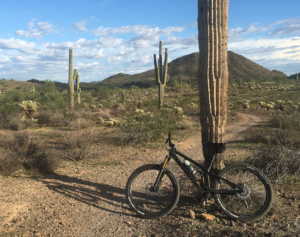
Concert of the week in Grateful Dead history: October 16, 1974 (Listen Now)
Once in a while you get shown the light, in the strangest of places if you look at it right.
By The Deadhead Cyclist
For Week
42
There are so many things I love about mountain biking that it would be impossible to list them all. But if I had to pick the aspect of the sport I love best, it would be that getting out on two wheels represents a true “sabbatical” from life. Once the rubber hits the dirt, and I embark on another adventure in the wilderness, my troubles promptly melt away. And after conquering a completely different set of obstacles on the trails, the ones waiting for me at the trailhead seem more manageable than they did just a couple of hours earlier.
The feeling of being “shown the light” I get during a mountain bike ride is reminiscent of the one that accompanies being at a Grateful Dead concert. It’s no coincidence that I always head to the hills with a concert carefully selected and downloaded onto my iPhone. During the month of October, my passions for mountain biking and the Dead collide with my love of baseball, as I head south to Arizona to play in the annual Men’s Senior Baseball League (MSBL) “World Series” tournaments.
In between games, I enjoy the dramatic change in scenery from the Rocky Mountains to the Sonoran Desert, and I always look forward to reliving the “Last Nights” from October, ’74 at Winterland, as I visit my favorite trails in the hot, “arid zone” of the Southwest. This Week In Grateful Dead History features 10/16/74, the first of the famous five-night stand – during which The Grateful Dead Movie was made – which included an early period version of the tune, Scarlet Begonias (before it was coupled with Fire on the Mountain), in which the title of this chapter is found.
It was while listening to the 10/16/74 Scarlet Begonias that I was “shown the light” of what I now refer to as the Trying Too Hard Principle. Applicable to athletic endeavors, such as cycling, as well as any other corner of life where effort is involved, the basic concept is this: There’s an energetic sweet spot, where the perfect amount of effort is applied toward achieving a certain outcome. If insufficient effort is expended, the outcome cannot be reached. However, the opposite is equally true: Trying too hard can result in diminishing returns where, at best, the outcome is achieved at excessive cost or, at worst, not achieved at all.
In my athletic endeavors, as in my life as a whole, I have often noticed myself, and others, exerting maximum effort, thinking that a desired result hangs in the balance. But what if the same result, or an even better one, can be achieved with less energy expended? If that were the case, this principle could be applied to the experience of aging as a way of counteracting the inevitable reduction of energy level experienced as we age. Perhaps, working smarter, rather than working harder, can be added to our toolbox in our desire to take control of the aging process.
I recently put the Trying Too Hard Principle to the test during an intense mountain bike ride in the desert wilderness of Arizona. As an experiment, I duplicated a ride I had done three days earlier, called the Sonoran Long Figure 8, in the Phoenix Sonoran Desert Preserve. On the first occasion, using maximum effort I had completed this 10.5-mile ride, featuring a grueling 1183 feet of elevation, in 1:16:40. On the second occasion, I decided to alter my riding style so as to exert less energy where possible (some of the steepest, chunkiest sections of this trail cannot be cleared with anything less than “full grind”), and focus on riding smoothly, using outstanding technique.
What I noticed over the course of the ride was a significant increase in my level of enjoyment. In other words, the “suffer factor” was reduced, and I found myself looking up and marveling at the stunning scenery more frequently.

The light shines on our human tendency to try too hard, and leads us in the direction of relaxing and believing in ourselves as the keys to greater enjoyment and superior performance.
Of course, that much might have been expected, and while one can hardly dismiss the value of a more enjoyable experience (in fact, to the contrary, it could easily be argued – and should be argued – that the joy experienced during mountain biking outranks the athletic achievement), the empirical result of the experiment would be found on my Strava app at the end of the ride.
To my surprise, despite the gentler approach, the second ride came in at 1:18:06, an increase of just eighty-six seconds, less than a two-percent difference! Which begs the questions: Is a more joyful experience worth an eight-six second reduction in athletic performance? And, what lesson does this offer us in the context of our desire to meet the challenges of life and aging?
In this revealing exercise, we acquire a powerful tool that can be used repeatedly as we move through our lives – and particularly into our older years – with the desire to continue doing what we’ve always enjoyed. Ironically, the tool is the knowledge that we’ve been trying too hard all of these years, and with little to show for it (eighty-six seconds over the course of almost an hour-and-a-half ride is what I call “little”). We’ve learned that sometimes in cycling or any other aspect of life we get shown the light “in the strangest of places (and trying to survive a climb in an Arizona desert qualifies as a pretty strange place), if we look at it right.” In this case, the light shines on our human tendency to try too hard, and leads us in the direction of relaxing and believing in ourselves as the keys to greater enjoyment and superior performance. When great athletes refer to “being in the zone,” they are moving more fluidly and effortlessly, as opposed to trying harder and exerting greater amounts of energy. In this principle lies one of the most powerful, albeit paradoxical, tools we can use in having the life we want, regardless of the number of candles on our most recent birthday cake.
The aging process at its best involves looking at life in an entirely new way. But let’s be clear: Looking at it “right” does not have to involve limitations, or worse, completely abandoning the things we love to do. Rather, we can look at life expansively, envisioning new ways of doing things that enable us to continue doing what we love and loving what we do. Based on my experiment, attempting to ride a trail as fast as I used to by intensifying my effort doesn’t lead in the right direction. Whether it’s cycling, gardening, writing, or any other endeavor that stirs our passions, finding a new way to get there, while increasing our enjoyment of the experience, is the potential that advancing age offers. In this way, we can live the best years of our lives with plenty of gratitude and no regrets.
Concert of the week in Grateful Dead history: October 16, 1974 (Listen Now)
Subscribe and stay in touch.